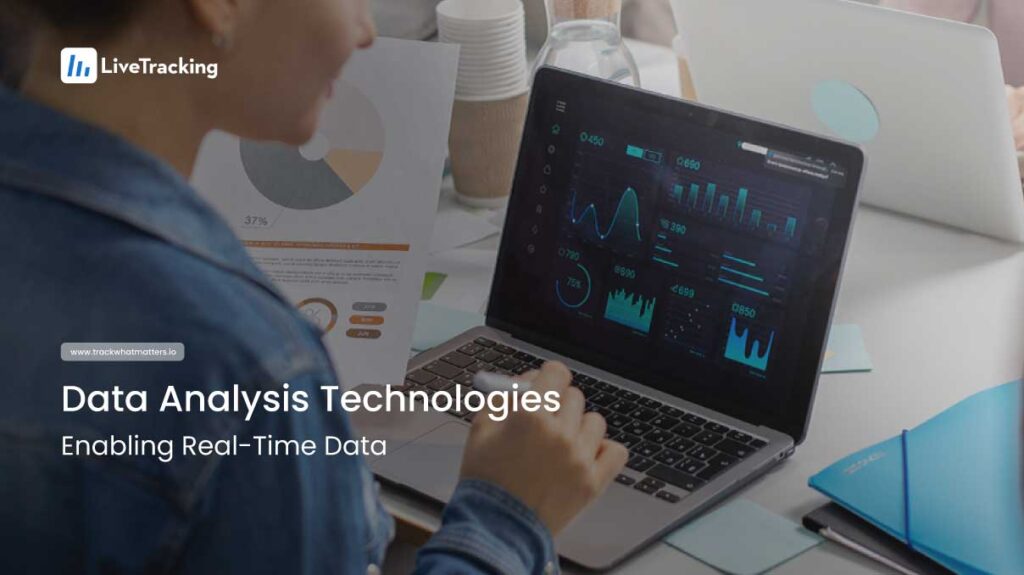Data Analysis Integration of MES with ERP and Other Systems
Manufacturing execution systems (MES) are essential to improving manufacturing efficiency, but their effectiveness depends on integration.
The effective use of real-time data analysis in manufacturing is made possible by IoT, edge computing, and AI-powered analytics. IoT-enabled sensors continuously collect manufacturing data, while edge computing processes it closer to the source to reduce latency. AI and machine learning further enhance data analysis by identifying trends, predicting maintenance needs, and improving operational efficiency.
LiveTracking offers an advanced data analysis solution that enhances equipment tracking, operational efficiency, and decision-making. Businesses can take advantage of a free demo trial to experience how LiveTracking optimizes real-time data analysis for manufacturing.

A range of technologies underpins the effective utilization of real-time manufacturing data. The Internet of Things (IoT) has emerged as a transformative power in manufacturing, allowing for the deployment of smart sensors and connected devices that capture data continuously. These IoT devices not only monitor equipment and processes but also communicate with one another, creating a cohesive network that enhances visibility across the entire production line. This interconnectedness enables manufacturers to track performance metrics in real-time, leading to quicker identification of inefficiencies and potential bottlenecks.
Edge computing is another significant advancement, allowing data processing to occur closer to the source. This not only reduces latency but also relieves pressure on centralized servers. With edge computing, manufacturers can derive insights in real-time, supporting immediate decision-making processes. By processing data on-site, manufacturers can respond to operational changes without the delays associated with sending data to a distant cloud server. This capability is particularly crucial in environments where split-second decisions can lead to significant cost savings or prevent equipment failure.
Finally, advanced analytics tools, powered by AI and ML, are essential for converting raw data into actionable insights. These tools facilitate trend analysis, benchmarking, and predictive maintenance, thereby driving efficiency across the manufacturing process. By leveraging machine learning algorithms, manufacturers can identify patterns and anomalies in their data that might not be immediately obvious. This predictive capability enables proactive maintenance schedules, minimizing downtime and extending the lifespan of critical machinery. Moreover, the integration of these analytics tools with visualization dashboards allows stakeholders to interpret complex data sets intuitively, fostering a data-driven culture within the organization.
As the manufacturing landscape continues to evolve, the integration of these technologies is becoming increasingly vital. The synergy between IoT, edge computing, and advanced analytics not only enhances operational efficiency but also paves the way for innovations such as digital twins and autonomous systems. Digital twins, for instance, create virtual replicas of physical assets, allowing for simulation and optimization of processes before implementation. This not only reduces risk but also accelerates the innovation cycle, enabling manufacturers to stay competitive in a rapidly changing market. Additionally, the rise of autonomous systems, powered by real-time data and AI, promises to revolutionize the workforce, allowing human operators to focus on more strategic tasks while machines handle routine operations.
Challenges and Solutions in Implementing Real-Time Data
Implementing real-time manufacturing data systems is not without its challenges. Among the most pressing concerns are the costs associated with upgrading infrastructure and training personnel to effectively utilize the new systems. However, manufacturers can overcome these obstacles by evaluating their current processes and investing in scalable solutions that provide long-term benefits.
One effective approach is to start with pilot projects focused on specific production lines or processes. This allows organizations to demonstrate quick wins and build a business case for broader implementation. Engaging employees through training and feedback cycles is also critical for ensuring that the transition to real-time data usage is smooth and accepted across the organization. Additionally, fostering a culture of continuous improvement can empower employees to contribute ideas and innovations, further enhancing the effectiveness of real-time data systems.
Data integration challenges arise when manufacturers attempt to consolidate information from multiple sources. Disparate systems, varied data formats, and inconsistent data quality can hinder the ability to obtain a comprehensive view of operations. To mitigate these issues, manufacturers should consider investing in unified data platforms that are designed specifically for manufacturing environments.
These platforms can integrate data from various sources, normalize it, and provide users with a single source of truth. Utilizing cloud-based solutions can also enhance scalability and accessibility, enabling real-time data utilization across geographically dispersed facilities. Moreover, establishing data governance frameworks is essential to ensure data integrity and security, as it helps maintain high standards for data quality and compliance with industry regulations. By prioritizing these governance measures, manufacturers can build trust in their data, leading to more informed decision-making and ultimately driving operational excellence.

Ready to unlock the full potential of real-time manufacturing data in your operations? LiveTracking is here to guide you on the path to agile production. By scheduling a quick discovery call, you can explore how our solutions not only simplify the tracking of critical statistics but also guarantee a remarkable increase in equipment efficiency. Don’t miss out on the opportunity to revolutionize your manufacturing process. Schedule a quick Demo call today and take advantage of our free full demo trial. Let’s discuss how LiveTracking can make your production more responsive and efficient within the next two weeks.
1. What is real-time data analysis in manufacturing?
Real-time data analysis in manufacturing refers to the continuous collection and processing of manufacturing data to monitor performance, detect inefficiencies, and improve operations instantly.
2. How does IoT enhance data analysis in manufacturing?
IoT-enabled smart sensors collect real-time data, enabling manufacturers to track performance metrics and optimize their production processes.
3. What are the challenges of implementing real-time data analysis?
Common challenges include high infrastructure costs, data integration complexities, and workforce training. Manufacturers can overcome these by adopting scalable solutions and unified data platforms.
4. How does AI improve manufacturing data analysis?
AI and machine learning enhance data analysis by identifying trends, predicting maintenance needs, and detecting anomalies, leading to improved operational efficiency.
5. How can LiveTracking help with manufacturing data analysis?
LiveTracking provides advanced real-time data analysis solutions, enabling businesses to track equipment efficiency, detect inefficiencies, and optimize production workflows effortlessly.
Share
Table of Content
Stay Up-to-Date
Get LiveTracking news in your inbox.
Error: Contact form not found.
By submitting this form I have read and acknowledged the Privacy Policy.
The latest industry news, interviews, technologies, and resources.
Manufacturing execution systems (MES) are essential to improving manufacturing efficiency, but their effectiveness depends on integration.
Unlock the full potential of your manufacturing operations with our comprehensive guide on MES implementation strategies.